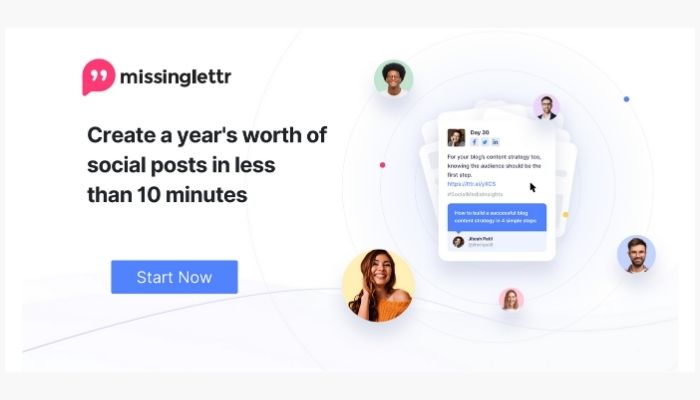What’s the key to achieve profitable, manageable content marketing for small business and personal brands like you?
Short of handing the responsibility off to a trusted and experienced provider (we’d all like that, right?), you need these three essential steps in your content marketing’s formula for success:
- Strategy and Planning
- Creation
- Promotion
Leave one out one of these foundational pillars and your results won’t be as effective or as sustainable. In other words, you’ll end up wasting a lot of time on content that doesn’t generate leads or sales. Plus you’ll fail to keep up with the workload.
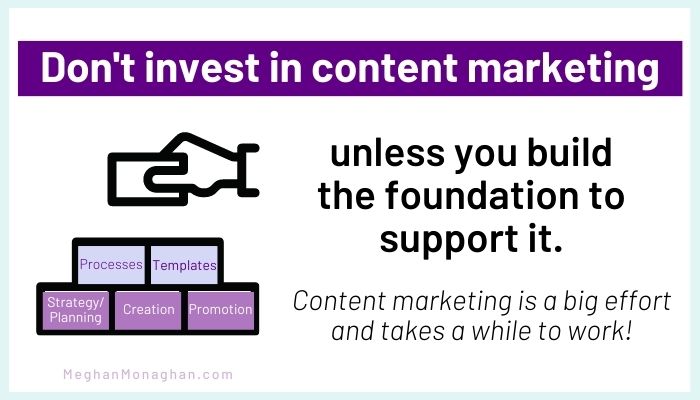
But, let’s focus on the positive! You’re fully capable of doing the three steps above to make content marketing a strategy that attracts leads.
Content marketing is awesome for small businesses, especially coaches, consultants, and individual service providers since YOU are the face of your business. Whether or not you realize it, your clients are buying you—your experience, your personality, your brain.
Your Original Uniqueness (Y.O.U.) makes you stand out, and it’s a big part of why people choose your products and services over the competition.
Content is one of THE best options to highlight Y.O.U., especially when it’s original, informative, and bursting with personality.
Your unique content:
- positions you as an industry expert
- differentiates your from your competitors
- attracts the right leads
- increases your visibility and reach (SEO) and
- boosts your influence (aka trust)
- converts more prospects into buyers (and hopefully lifelong buyers!)
Content is one proven way to acquire more opportunities and more sales. So, let’s talk about the formula for success!
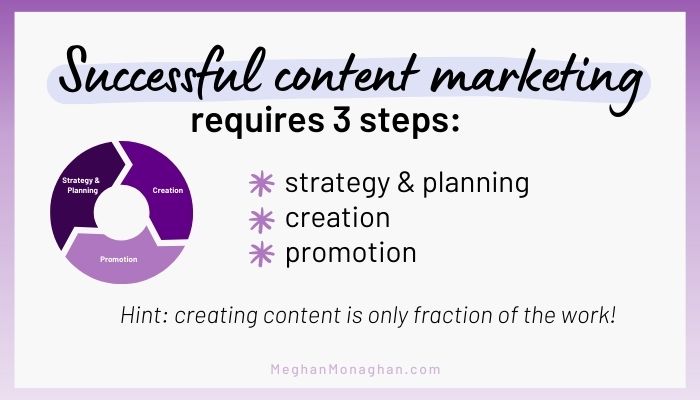
1) Content Strategy and Planning
You wouldn’t set out on a road trip without a destination and directions to get there. Likewise, you need business goals and a strategic plan to reach them.
Strategy and planning are the foundation of your content marketing. They are a critical initial step or phase in creating content that 1) supports your business and 2) appeals to your ideal clients.
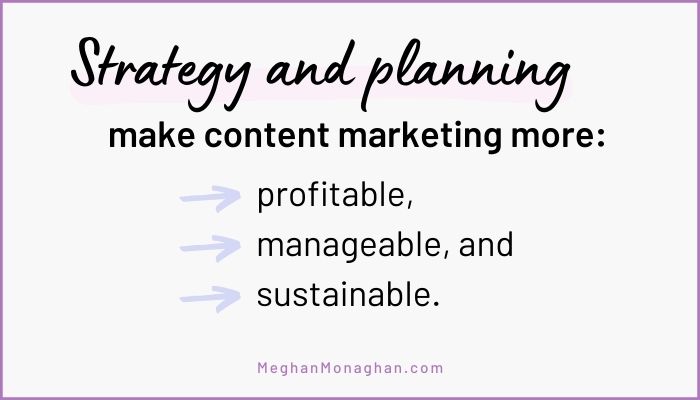
Defining the what, why, who, and how provides you with much needed direction both for your content creation and for managing it all. Otherwise, content marketing will overwhelm you!
Haphazard content marketing leads to wasted time, frustration, and quitting.
Here are a few examples of things that get sorted out in the Content Strategy and Planning phase:
- Target market/audience/avatar
- Competitive analysis
- Content audit, strategy and analysis
- Keyword phrase identification
- Content calendar
- Website audit
- SEO strategy and tactics
- Content management
- Processes and Systems
- Tools and apps
What is a Content Strategy?
A content strategy is a documented plan that aligns your blog, video, and audio content with your business goals, target market, and your products or services. It identifies what content to create to attract more leads and convert them into buyers so that your marketing is profitable for your business.
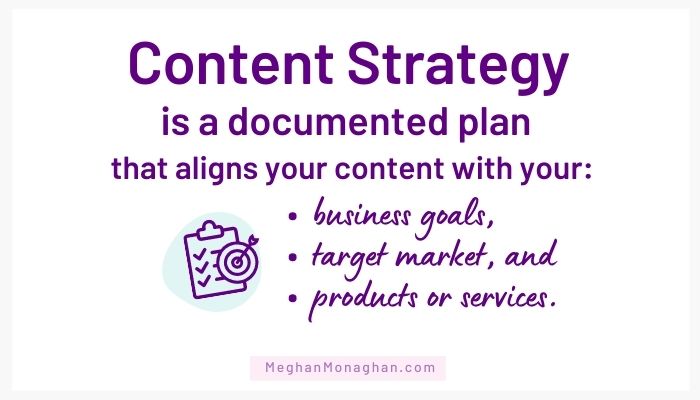
With strategy, you answer questions like:
- What kind of content should I create?
- Who am I producing content to attract and appeal to? (target market/avatar)
- Why am I publishing this content (aka business goals)?
- What content should I create?
- Who is my competition?
- What is my competition’s content like?
- What are my key topics, subjects, and themes?
- What’s my publishing plan?
Answering these questions guides your content creation so that your decisions are much more strategic and relevant to your audience and business goals.
What is Content Planning?
Content planning is transforming your strategic ideas and concepts into actionable tasks.
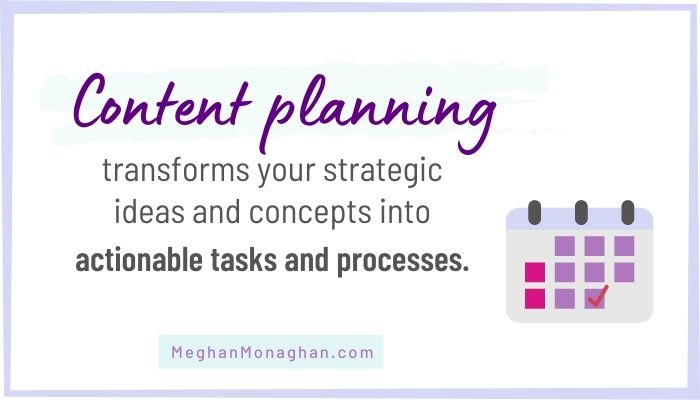
This is where the content calendar comes onto the scene as one of the next steps after strategy. The calendar plans your topics, keywords, titles, and publishing dates. It’s an outline for what to create, why, and when.
Check out my done-for-you Profitable Content Calendar 😎
You then need a process or system to carry out that calendar plan. Typically, that’s turning the content calendar data into tasks and due dates in your project management app. Eventually, those items go in your daily planner and on your work calendar.
Planning helps you maintain three very important characteristics of successful content marketing:
- Commitment
- Consistency
- Quality
Commitment makes it possible to stick to your plan. Content marketing is a marathon, not a sprint. Planning ahead makes you less likely to give up and quit.

Consistency means you show up regularly for your community and for the algorithms. This makes an enormous difference in content marketing. Your effort builds trust, credibility, and authority with an audience and with search algorithms (see more about E-A-T).
Finally, your content has to be high-quality. You want to stand out, draw attention, and show off your expertise, which calls for Clout Content.
What is Clout Content?
Clout Content—aka authority content—boosts your influence and reputation through the sharing of knowledge, frameworks, beliefs, thought leadership, and your unique personality. It convinces your audience to trust you and proves that you’re a credible resource.
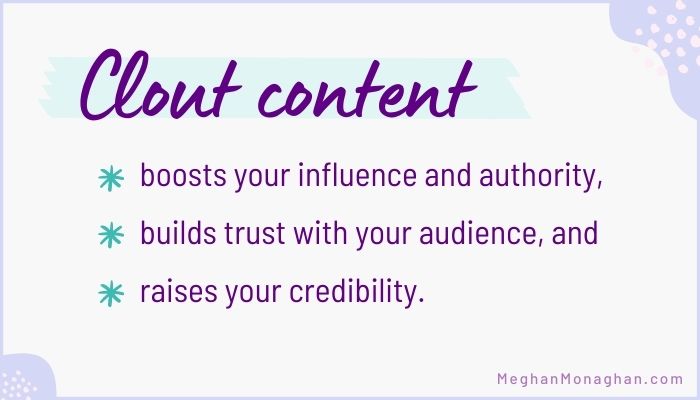
Anyway, don’t overlook or undervalue planning. It will be how you are able to keep up with managing your content, whether you do it yourself or you hire help.
Looking for content marketing help? My Content Profit Plan analyzes where you are now and gives you a path forward based on your business goals 😀
What are the Benefits of Content Strategy and Planning?
If you’re committed to consistent lead generation, then you need a roadmap to guide your content marketing. Strategy and planning are the roadmap that make it possible to:
- Choose the best content to attract your target market
- Determine the content that will make it possible to meet your business goals
- Set and meet deadlines
- Manage your content marketing on your own or with a team through a process
- Assess and analyze your results
- Keep up with content marketing on a consistent basis
By the way, a content roadmap keeps you going so that you don’t give up. This is important because consistency is a requirement of profitable, successful content marketing for small business.
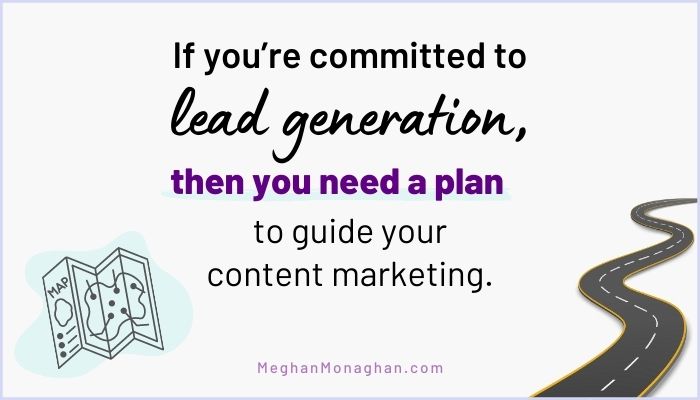
Once the content process becomes too overwhelming, your marketing will become inconsistent, and then it becomes ineffective. Believe me, I know this first hand!
“…the year-over-year needle is stuck at around only 40% of marketers having a documented content marketing strategy. Without a strategy, too many content marketers are creating content for the sake of creating content…” – Content Marketing Institute 13th Annual B2B Content Marketing Benchmarks, Budgets, and Trends: Insights for 2023
So when you think about content strategy, think about planning as a part of it. The two go hand in hand. As my business coach always says, “You’ve got to plan your work and work your plan.”

2) Content Creation
After your strategic roadmap and plan are done, it’s time to get to work creating your content. Thanks to strategy and planning, you know what to create, which makes execution easier and less prone to barriers (aka excuses!).
Unfortunately, content creation consumes a lot of time. Often it falls to the back burner for most small businesses. How can you manage creating content when you don’t have a big marketing department or budget?
For very small teams, I recommend creating processes and templates plus following the Authority Hub System to manage content marketing. Ideally, you start with ONE main content asset, or what I call an “Authority Hub,” and reuse it to keep up with content creation demands.
What is an Authority Hub?
An Authority Hub is where you publish your most authoritative, in-depth content that you reformat and reuse on other channels or platforms. Typically, an Authority Hub is a blog, vlog (a blog in video format), or podcast.
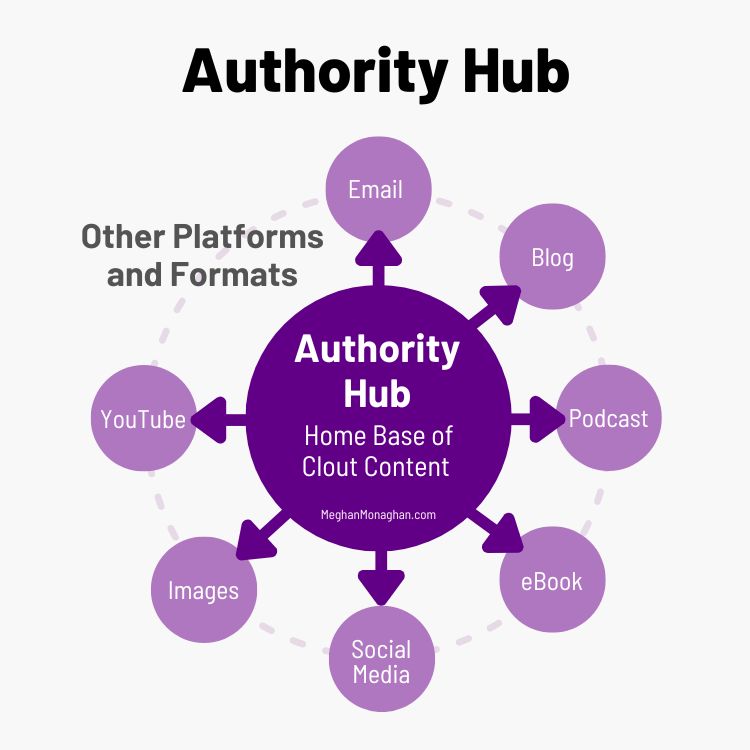
Ideally, your Authority Hub is online real estate that you own and control, such as a website blog or audio files on your site. However, this isn’t always possible. A YouTube channel or a Substack blog may be what you use as your Hub.
Word of caution: when you choose a platform that you don’t own, then others control your content. These platforms decide what content can be published, when it can be accessed, and other details that are completely out of your control.
How to Manage Content Creation as a Small Team: The Authority Hub System
The Authority Hub framework is a process that makes it possible to keep up with content marketing. You save time because you’re not starting from scratch for each piece of content.
Converting your Hub content into other formats is often called “repurposing.” These other formats don’t have to be exact copies of your Hub content.
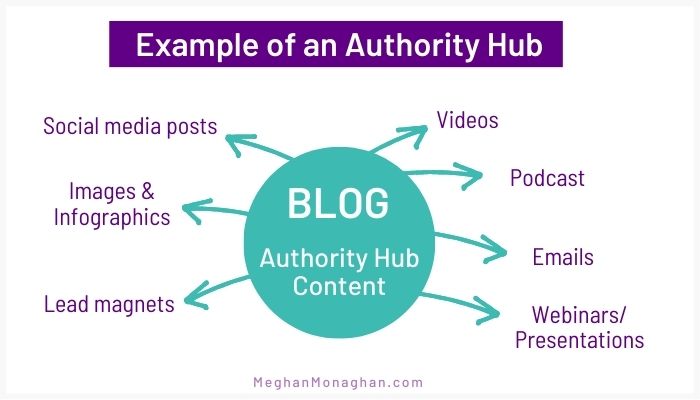
For example, you could use your website blog as an Authority Hub. Each week, you publish a post and use that post to generate social media posts, a YouTube video, and an audio file that you also publish as a podcast episode. Perhaps your weekly email to your subscriber list also uses content from the blog post.
(Note: this is not related to the Hub and Spoke Model, which is a strategy in content marketing and SEO.)
Let’s face facts. If you were to create brand new content for a blog, vlog, and podcast without a marketing department, you’d spend all of your time creating content! There’d be no time left for actual business.
Instead of creating all new content all the time, you use one piece of content multiple ways.
And, a huge advantage of following this system is that you can outsource some, if not all, of the work.
Avoid Overdoing it When it Comes to Content Creation
If you only have time for creating Clout Content for your Authority Hub, then commit to doing only that.
It is more effective to create great content on one platform than to create mediocre content so that you can be everywhere online.
Focus on developing strategic, authoritative content and building your Authority Hub. You can always go back and use the Hub System later when it makes sense for you.

By the way, I don’t recommend more than one Authority Hub for small businesses. Big corporations can handle loads of content creation. However, unless you’re outsourcing much of the workload, you’ll struggle with even the most basic content creation demands and end up stopping due to overwhelm.
The Creation Phase Requires More Than Writing or Recording
I don’t know about you, but every time I contemplate painting a room in my house, I underestimate the time it’s going to take me to paint. Just a few hours, right? No way!
Painting seems easy enough. And that’s because it is relatively easy…but it’s also time consuming. It involves many other tasks other than painting.
The takeaway? Just because something is simple, straightforward, or easy doesn’t mean it’s quick, fast, or immediate.
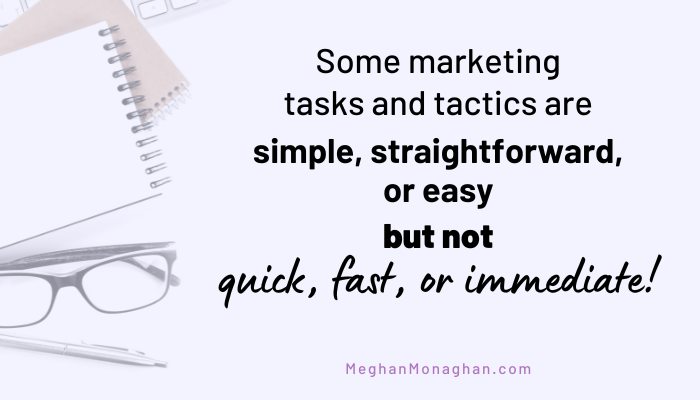
Even if creating content comes easy to you, don’t overlook all of the other related and often necessary steps.
Here are just some of the things you may have going on in the Creation phase:
- Research
- Writing and re-writing
- Editing (text, video, audio)
- Blogging
- Podcasting
- Scripting
- Video or audio recording
- Image design
- Copywriting
- Website work
- SEO
Many small businesses spend too much time in the Content Creation phase, especially if they don’t follow the Authority Hub System. Even managing any content creation at all can be overwhelming for some.
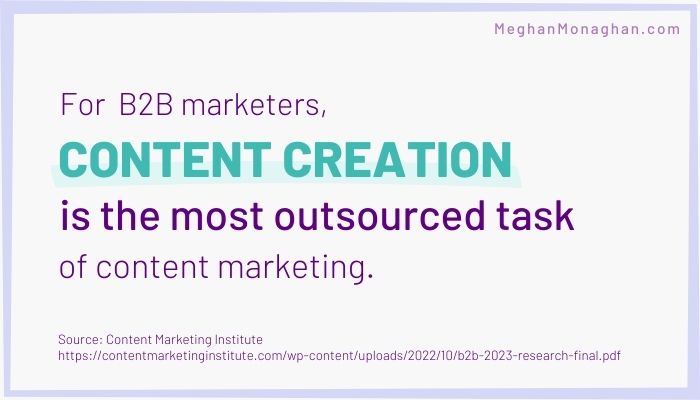
It’s no surprise that content creation is the most outsourced task of content marketing for B2B marketers. (SOURCE) It is the perfect area of content marketing to outsource, especially if you aren’t an experienced writer, designer, tech person, or SEO expert.
Having a team or even an assistant can make a huge, positive impact on your marketing and your business.
Outsource the work you can. Break up the tasks into steps and stages, transfer that information to a project management tool and onto your calendar, and hire help.
Where Does Updating Content Fit In?
One area of content creation that you don’t want to ignore is refreshing – or updating – older content.
If you have older content that is still of interest to your target market, it’s probably worth updating it – as long as it’s still relevant to your business.
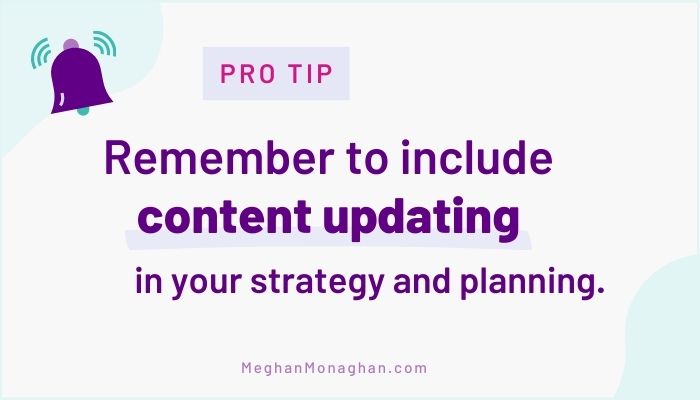
Updating older content should be addressed in your Strategy and Planning when you audit your content.
Sometimes “refreshing” translates to extensive research, rewriting or redoing content completely. And, that’s nearly as much work as starting from scratch. So, you’ll need to assess older content and put it into your schedule for updating if necessary.
3) Content Promotion – the ‘Marketing’ of Your Content
Now that you’ve got your plan and content, your next step is promotion. Only content that is seen and consumed can grow your business!
It’s up to you to get your content in front of your target audience, aka the people who you created it for.
This is the more “marketing” focused part of content marketing. 😉
What is Content Promotion?
Content promotion is the organic (ie. free) and paid distribution and amplification of your content across multiple platforms and channels. The end goal is to get more people to see and consume your content.
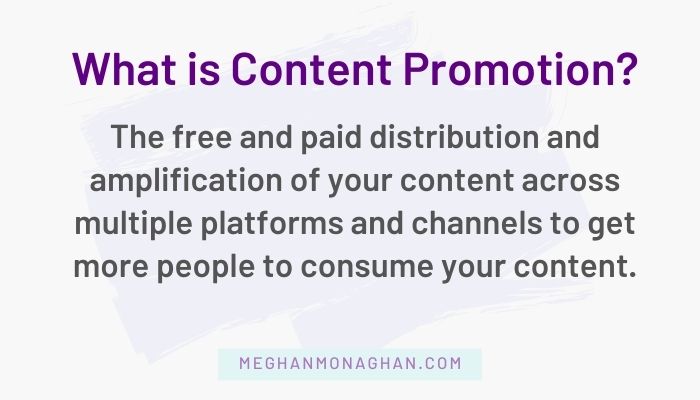
The benefits of content promotion extend beyond getting your message and information in front of others. Getting more traffic can result in:
- more leads and sales;
- improved SEO; and
- increased visitors to your content.
Experts say that you should spend 20% of your time creating content and 80% promoting it.
How to Promote Your Content
There are many methods to promote your content. It’s not about doing all of them!
If you’re a team of one, choose one or two that make sense for your business, personality, brand, and market. When you have a team, you can incorporate more methods.
Again, processes and templates will save you time and energy, so develop your own. When you’re ready to hire help, these two things will make it much smoother.
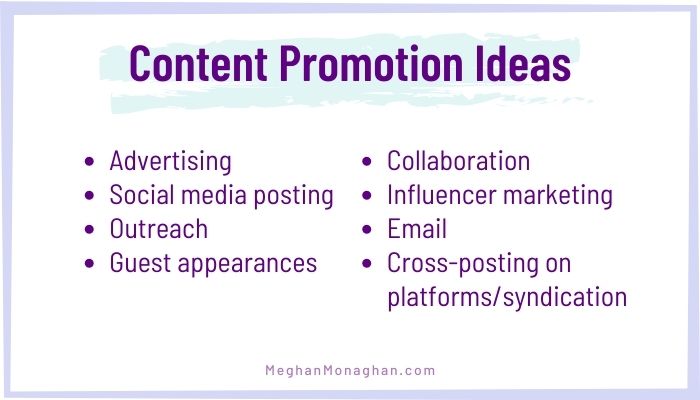
Here are some ways to promote your content:
- Advertising
- Social media posting
- Outreach
- Guest appearances
- Collaboration
- Influencer marketing
- Cross-posting on platforms/syndication
Will your target audience come across your content without promotion? Possibly. But you need a committed effort to drive traffic to your content.
In the end, it’s a numbers game. The more people in your target market who see your content, the higher the chances of converting them to a lead or sale.
I love strategy, planning, and creation. But promotion? Not so much. I have to force myself to promote my content through planning and time blocking on my calendar.
With content distribution, you establish your plan for promoting and marketing your content. You answer questions like:
- What tactics will I use to get more eyeballs on my content?
- What social media platforms will I use?
- How much money will I invest in promotion?
- When will I promote the content and where?
- How much time will I devote to promotion tactics?
Here are a few examples of things that get sorted out in the Content Distribution Phase:
- Content marketing strategy and plan
- Social media strategy
- Social media management
- Tools and apps
Organic versus Paid Promotion
In general, there are two types of promotion: organic (aka free) and paid. Both have positives and negatives.
Note: organically promoting your content has a cost, and that cost is time. Either your time or someone else’s time. In the case of the latter, that’s not free. 😉
One of the great aspects of paid promotion is that often you can do a better job of choosing who sees your content. You can target your audience by demographics and other characteristics or filters.
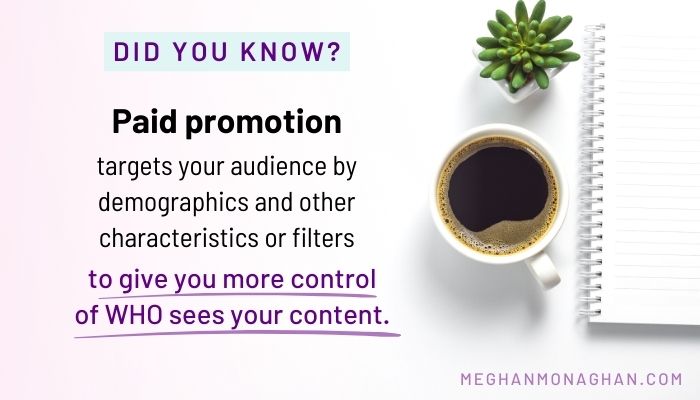
On the flip side, people don’t prefer ads. People are often skeptical of content that is promoted. When was the last time you saw an ad on Facebook that didn’t want you to buy something? So, people expect your paid promotion to end in you asking them to do something.
By the way, it’s not wrong to try to make a sale. And, offsetting your ad costs with a paid offer is a strategy used successfully by many marketers. However, that’s a different customer journey than trying to get a potential lead to watch a video or read a blog post, no strings attached.
There are other avenues for paid promotion outside of advertising, such as tools that have a monthly or annual fee.
For example, Missinglettr and Quuu Promote can increase your blog content’s exposure. MissingLettr helped me schedule a YEAR of social posts for my podcast, which really saved me when we went through several back-to-back family crises over four months.
And, Follow.it notifies its users when your new blog launches. I use Follow.it for The Messy Desk Podcast as an alternative to email marketing.
I recommend trying out different promotional tactics to see what works for you and your budget. Start by allotting at least 30 minutes a week to content promotion efforts.
What’s Next?
A content marketer’s job is never done.
After you’ve completed all three of these steps, you’ve come full circle because now it’s time to analyze your results. That puts you back into the Strategy and Planning phase since you’ll be auditing your work, assessing it, and planning your next steps. This is where those content marketing metrics and blogging goals make a big difference!
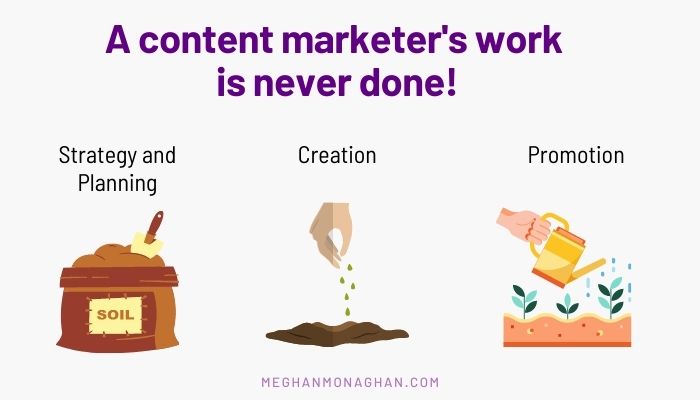
What I’ve laid out for you here is a top-level look at how to achieve profitable, sustainable content marketing. Planning is preparing the soil, creation is planting the seed, and promotion is watering the plant so it can grow and flourish.
Does it sound overwhelming? At first, it is.
Start small. Choose one thing to tackle at a time.
Set realistic, attainable goals for your content marketing. Start with strategy and planning to identify both your marketing needs and your bandwidth.
Allow yourself time for trial and error, and don’t give up! If you can’t keep up, decide what you can manage, modify your goals accordingly, and try again. Failure is a great teacher!
Content Marketing for Small Business is Work and Takes Time
Content marketing isn’t for everyone. It may not be right for you!
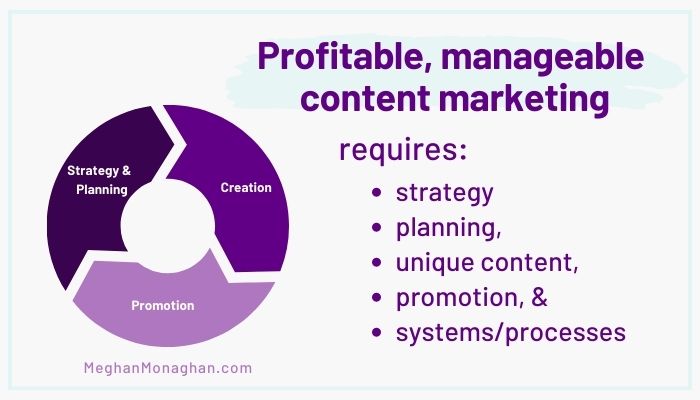
Hopefully, the insight provided in this post gave you a glimpse into what’s required if you’re going to be a successful content marketer.
When it comes to content creation and promotion, the only way to manage it solo or with a small team is through planning and implementing the plan via systems or processes you create.
If you intend on managing your content without a marketing department, you must have content marketing that is:
- Profitable – to support your business and revenue goals
- Manageable – to make it possible for you to carry out the tasks at hand
- Sustainable – to maintain #1 and #2 in an ongoing, consistent manner
Some of the biggest impact in my content management has happened through simple changes such as:
- Setting deadlines
- Developing templates and processes
- Identifying tasks & breaking them up into smaller tasks
- Putting tasks into a pm tool
- Adding tasks to a cloud-based calendar
The key to managing your content marketing on your own is to plan your time and develop systems or processes.

And guess what? When you’re ready to hire help, these existing systems and processes will make it much easier. The organization will exist and the hand off or the incorporation of people into your business will be much less of a headache. Yippee!
Strategy, planning, and systems make profitable content marketing for small businesses achievable. And, that’s what the end goal really is: profits!
FAQs About Content Marketing for Small Business
Do I need to outsource content marketing?
Not to start. Ultimately, however, you will likely need to outsource somewhere in your business and content is a good place to begin. Eventually you will want to outsource! You’ll be so busy with your zone of genius and generating revenue that it makes life better to outsource content creation and promotion.
Does content marketing cost money?
Everyone says content marketing is free except for your time. I disagree. Firstly, your time is worth money. So, there’s the first expense.
Content marketing is good for a tight budget. As far as an outlay of cash, it doesn’t require loads of money. You can bootstrap it.
But, running a business costs money. While content marketing is less expensive than advertising, there is still an investment at multiple stages in the process.
Is content marketing good for small teams or is it more for medium sized enterprises with bigger teams and budgets?
Content marketing is a terrific, plausible way for coaches to build a brand, establish authority, get known, and generate leads.
If you need hep with your content marketing strategy, please contact me to set up a free consultation.

